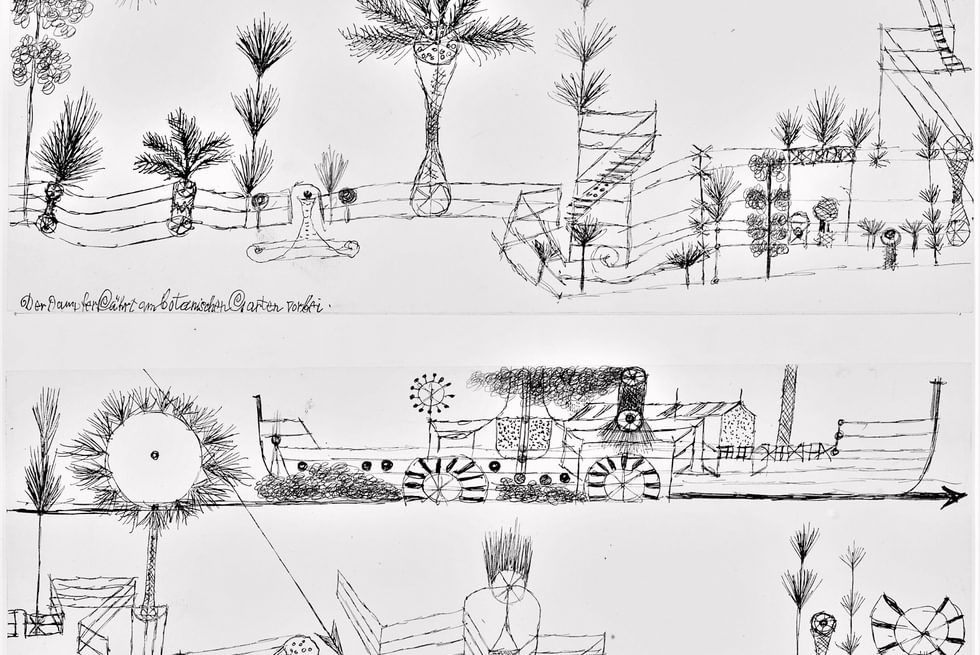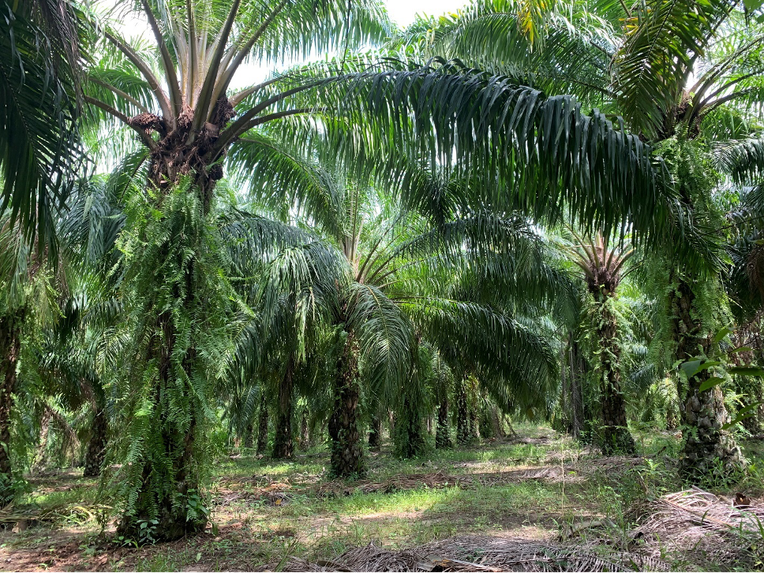Plantationocene “On the Ground”
From the Series: Plantationocene
From the Series: Plantationocene

I take a bite from a chocolate bar while I’m writing my notes after meeting with J, an executive from a company that trades vegetable oils with offices in the Netherlands. The sweetness spreads in my mouth as the chocolate slowly melts. It feels silky smooth, yet solid. This is an important feature of a good chocolate bar. I knew this, but not with words, until I met a senior scientist at a Mexican vegetable oils company where I previously worked. Good chocolate should not melt easily. Fat helps keep it from doing so, allowing chocolate to travel from warehouses to trucks, from supermarket shelves to my back pack, all without compromising its smooth mouth-feel.
Palm oil is a crucial technology for making tasty, affordable, durable, and ready-to-eat foods.

But it is also linked to violence, dispossession, and environmental degradation (Alonso-Fradejas 2015; Chao 2018; Li and Semedi 2021; Ojeda et al. 2015). In the late 1990s, Asian-European transnational activism focused on deforestation, and their association with well-known brands and companies (Pye 2013). Among them, the company where J has worked for almost thirty years. A combination of reputational and ecological risk management has mobilized the agrifood industry toward “sustainable palm oil."
During the opening speech of a sustainability event of the palm oil industry in the Netherlands, the director of the multi-stakeholder Roundtable of Sustainable Palm Oil (RSPO) opened the forum saying that Europe was “the engine of sustainability.”
When I asked J whether he agreed with this view, he immediately said yes. “Europe is a net importer” he explained, “when we import goods, we import deforestation.” He went on to explain that the Netherlands’s wealth and financial stability allowed it to attend to such environmental and social issues, in contrast to Latin American or Asian countries with more urgent priorities.
The sustainable palm oil value chain is a geography of imagination (Trouillot 2003) that locates the problem of planetary transformation on the plantation and in farmers’ practices—somewhere in the tropics. And the “engine” of change in Europe.
Trouillot (2003) argues that the geography of imagination is always intertwined with a geography of management. The project of Europe as the “engine of sustainability” and a “net importer” has implemented different modes of management such as traceability of the plantation, and data analysis of soils, plants, and people.
I asked J about the recent European Union (EU) regulation of deforestation-free products. “Deforestation-free is the minimum requirement for any company.” He then specified that the strict legislation was “disconnecting us from the problems on the ground, instead of helping.” The disconnection refers to the possibility of not being able to source from Asia due to the high risk of deforestation. By “us” he meant European industries. By “problems” he meant deforestation. By “on the ground,” he meant where oil palm is planted. And by “helping,” J is talking about management and technological interventions on the plantation.
“On the ground” expresses the perception that being closer to a place—in this case, the plantation—provides both epistemological authority and leverage for social transformation. Why some places receive more attention and intervention than others? Our conversation reminded me of the history of fieldwork in the epistemic legitimization of anthropology. As Trouillot (2003) suggests, where and how do we imagine our fieldwork is part of colonial projects and geographies of management.
I suggest, the Plantationocene situates the political ecologies of our field sites, and our positionality in relation to them.
The Plantationocene literature argues that the ecological crisis is part of ongoing racialized colonial projects that can be traced to the modes of production of the plantation (Davies et al. 2019; Ferdinand 2022). At the sustainability event, representatives from Indonesia and Malaysia confronted corporate representatives about how the E.U. resolution affected “producing countries” like them. Nobody at the event mentioned the intimate history between the Netherlands, Europe’s main palm oil importer, and Indonesia, the largest palm oil producer. Although the latter’s oil palm plantations became highly profitable in the postcolonial era, historians and anthropologists have shown that the conditions for those profits developed in the racialized land and labor regimes of Dutch colonial occupation (Li and Semedi 2021; Robins 2021). The geography of imagination of the palm oil value chain (e.g., net importer, producing country, etc.) was produced by colonial relations. What responsibilities and reparations could emerge if we consider their trading partnership under the perspective of colonialism?
I feel the chocolate in my mouth.
It’s very possible that the palm oil from Indonesia is mixed with palm oil from other continents, and go through different stages of transformation to end up in my body while I eat in the Netherlands or elsewhere. Each location with different colonial and socioecological relations. Yet, the revitalized attention to plantation as an object of study runs the risk of using the term interchangeably between locations and value chains.[1]

The relevance of palm oil is not a stable continuity of the Dutch colonial occupation nor a demand from nowhere.[2] This problem is part of the structural position of anthropology. Trouillot (2003) identifies how anthropology originates to fill[3] the geography of imagination of the colonial utopia and remains in that position legitimizing imaginaries; for example, the plantation as a site for sustainable transformation. Considering that the plantation is the figure where to study the Plantationocene on the ground is part of a geography of imagination (and management) that requires critical analysis.
Why is my mouth-eating-chocolate, or J's office in the Netherlands any less on the ground than a farmer's plantation in Malaysia? Why is deforestation solved on the plantation and not somewhere else?
The Plantationocene recognizes colonial sociomaterial entanglements at multiple tempo-spatial scales, between people, plants, and planet (Barua 2022). But it also opens questions over how to study the situatedness, and difference between agro-industrial modes of production and consumption. Products with palm oil are not everywhere but in specific commodities, bodies, locations. Craving tasty, and solid, chocolate during a tough day at work is part of the oil palm plantation political ecologies.
[1] See Moore and Arosoaie (2022) for a discussion on how to teach “plantation worlds” from a critical perspective.
[2] For example, Mintz (1986) shows the historical and geographical changes of the demand for sugar.
[3] See Trouillot (2003, 133–135) for a clear explanation of how the utopian rhetoric of the savage slot is (re)produce through anthropological fieldwork.
Alonso-Fradejas, Alberto. 2015. “Anything but a Story Foretold: Multiple Politics of Resistance to the Agrarian Extractivist Project in Guatemala.” The Journal of Peasant Studies 42, no. 3–4: 489–515.
Barua, Maan. 2022. “Plantationocene: A Vegetal Geography.” Annals of the American Association of Geographers 113, no. 1:1–17.
Chao, Sophie. 2018. “In the Shadow of the Palm: Dispersed Ontologies among Marind, West Papua.” Cultural Anthropology 33, no. 4: 621–49.
Davis, Janae, Alex A. Mouldon, Levi Van Sant, and Brian Williams. 2019. “Anthropocene, Capitalocene, . . . Plantationocene?: A Manifesto for Ecological Justice in an Age of Global Crises.” Geography Compass 13, no. 5.
Ferdinand, Malcom. 2022. Decolonial Ecology Thinking from the Caribbean World. Translated by Anthony Paul Smith. Cambridge, U.K.: Polity Press.
Li, Tania, and Pujo Semedi. 2021. Plantation Life: Corporate Occupation in Indonesia’s Oil Palm Zone. Durham, N.C.: Duke University Press.
Mintz, Sidney W. 1986. Sweetness and Power: The Place of Sugar in Modern History. New York: Penguin Books.
Moore, Sophie Sapp, and Aida Arosoaie. 2022. "Plantation Worlds." Teaching Tools, Fieldsights, June 14.
Ojeda, Diana, Jennifer Petzl, Catalina Quiroga, Ana Catalina Rodríguez, and Juan Guillermo Rojas. 2015. “Paisajes del despojo cotidiano: acaparamiento de tierra y agua en Montes de María, Colombia.” Revista de Estudios Sociales 54: 107–119.
Pye, Olivier. 2013. “An Analysis of Transnational Environmental Campaigning Around Palm Oil.” In The Palm Oil Controversy in Southeast Asia, edited by Olivier Pye and Jayati Bhattacharya, 179–198. Singapore: Institute of Southeast Asian Studies Publishing.
Robins, Jonathan E. 2021. Oil Palm: A Global History. Flows, Migrations, and Exchanges. Chapel Hill: University of North Carolina Press.
Trouillot, Michel-Rolph. 2003. Global Transformations: Anthropology and the Modern World. New York: Palgrave Macmillan.